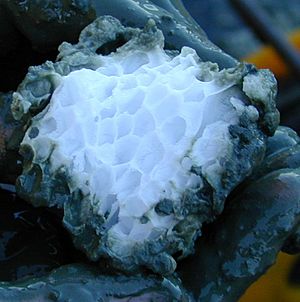Methane hydrate facts for kids
Methane hydrate is like frozen water that traps methane gas. You can think of it as "methane ice." Tiny water molecules form cages around the methane. It's often found deep under the ocean floor. Scientists first found it in the Black Sea in 1971.
Contents
What is Methane Hydrate?
Methane hydrate is often called "methane gas surrounded by ice." But it's more like methane gas trapped inside tiny, cage-like structures made of water molecules. These "cages" are super small, too tiny to see without special tools. If you melt just one liter of methane hydrate, you get about 168 liters of methane gas!
How Methane Hydrate Forms
Methane hydrate is believed to form from dead plants and animals that get buried deep under the Earth. Over time, tiny living things called microorganisms and the Earth's heat break down this organic material. This process is similar to how methane gas is made in a garbage dump when waste is covered with earth. But this happens far below the Earth's surface. Special methanogen Archaea (a type of microorganism) create the methane through a process called fermentation.
Where is Methane Hydrate Found?
Natural methane hydrate is usually found deep under the ocean. It's common in areas where huge land plates (called continental plates) meet. You can find it at depths between 500 to 1000 meters (about 1,600 to 3,300 feet). At these depths, the pressure is very high, and the temperature is low enough for it to form.
How Can We Get Methane from Hydrate?
Scientists are exploring different ways to get methane gas from these hydrate deposits. Here are some ideas:
Using Heat to Release Methane
One way is to drill a well down to the methane hydrate layer. Then, hot water or steam is sent down the well. This heat makes the methane hydrate break apart. When it breaks apart, it releases methane gas. The gas mixes with the hot water and comes back up to the surface, where they are separated.
Lowering the Pressure to Get Methane
Methane hydrate layers are under a lot of pressure from the weight of the ocean and the ground above them. The depressurization method works by lowering the pressure inside the well. When the pressure drops, the methane hydrate breaks down into methane gas and water.
Injecting Chemicals to Release Methane
Another method involves injecting a special chemical, like methanol, into the methane hydrate layers. This chemical helps the methane hydrate break apart without needing to change the temperature or pressure of the layer.
Why Methane Hydrate is Important and Dangerous
The Importance of Methane Hydrate
Many experts believe that methane hydrate deposits around the world hold a huge amount of energy. Some even say it's twice as much energy as all the oil, gas, and coal we've ever found combined! This could be a big energy source for the future. It might help us as we move away from using other fossil fuels and nuclear energy.
The Danger of Methane Hydrate
Methane is a very strong greenhouse gas. This means it traps heat in the Earth's atmosphere. If large amounts of methane gas were suddenly released from these deposits, it could cause big changes to our climate. Scientists think this might have happened in the past, and it's a concern for the future.
Images for kids
See also
 In Spanish: Hidrato de metano para niños
In Spanish: Hidrato de metano para niños






